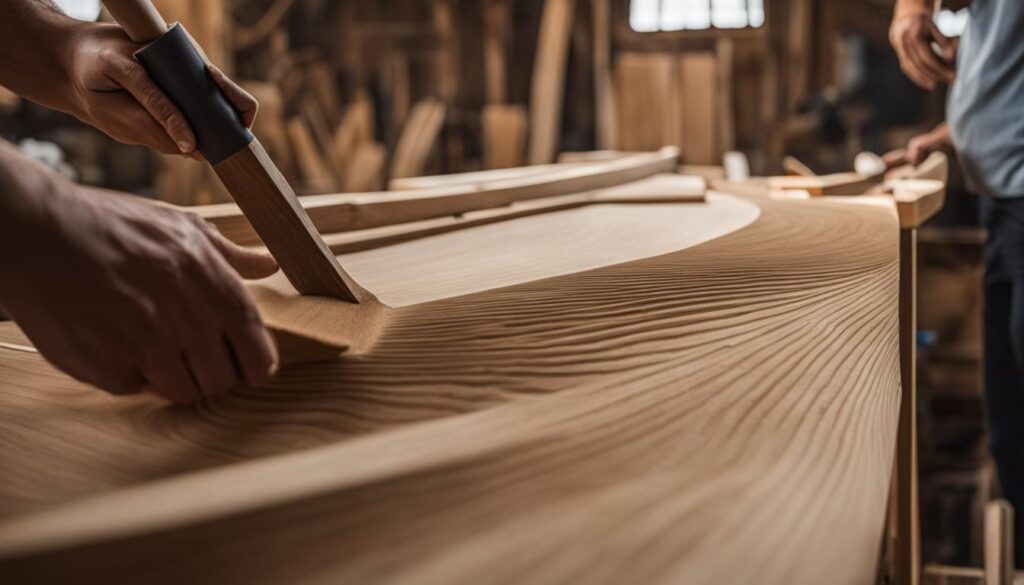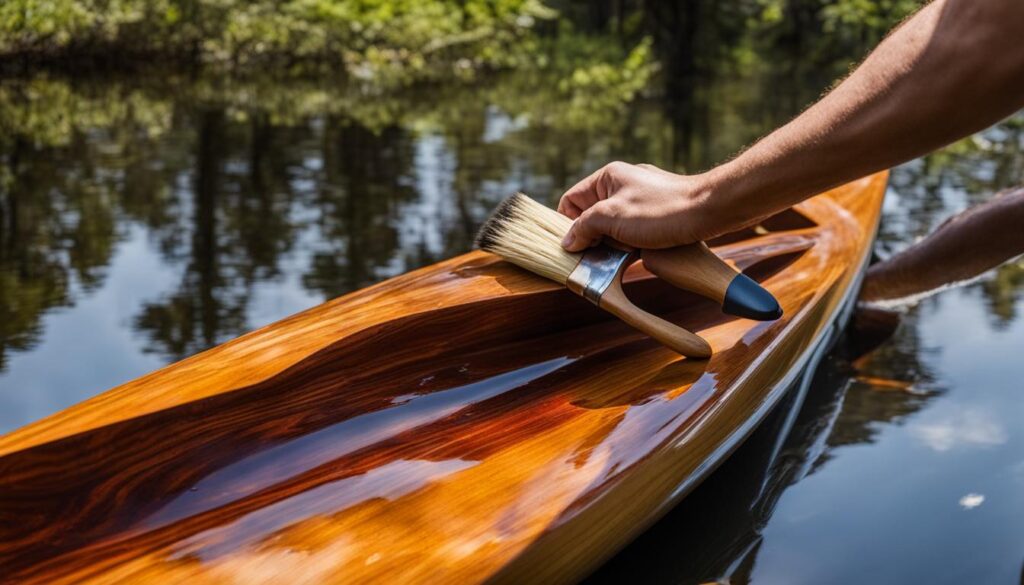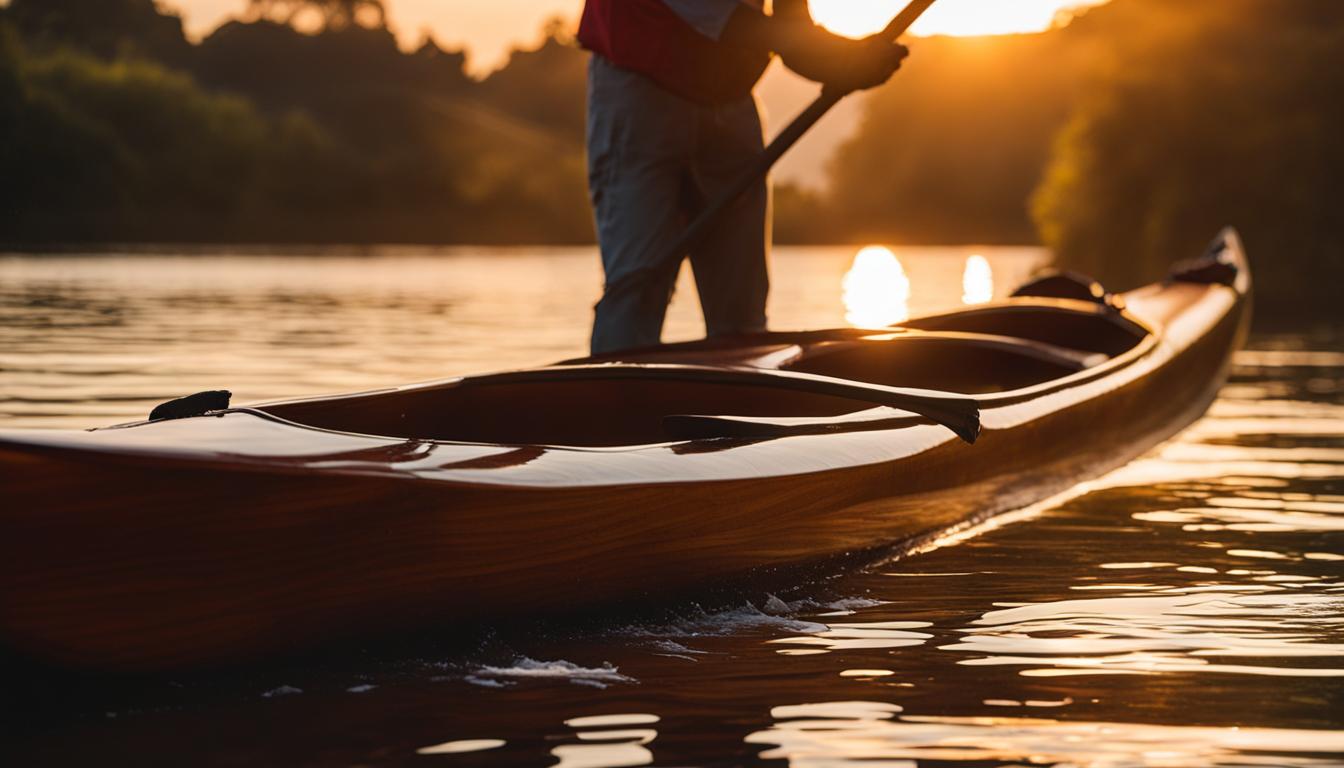When it comes to preserving and enhancing the beauty of your wooden kayak, choosing the right protective finish is crucial. There are various options available, each offering unique benefits and considerations. From varnishes to sealants, understanding the different types of finishes can help you make an informed decision that suits your needs and preferences.
Wooden kayak finishes not only provide protection against the elements but also add a touch of elegance to your vessel. Whether you’re looking for UV resistance, a glossy appearance, or enhanced grip, there’s a finish out there that can meet your requirements.
Common choices for wooden kayak finishes include spar varnish, tung oil, Watco Danish oil, hemp oil, and epifanes or la tonk varnish. Each of these options offers its own unique qualities, so it’s important to consider factors such as durability, maintenance, and ease of application when making your selection.
Key Takeaways:
- Choosing the right finish is essential for protecting and enhancing your wooden kayak.
- Consider factors such as durability, appearance, and ease of application when selecting a finish.
- Popular options include spar varnish, tung oil, Watco Danish oil, hemp oil, and epifanes or la tonk varnish.
- Multiple coats and sanding between each coat yield the best results.
- Consider the specific needs of different kayak parts and select finishes accordingly.
Sanding and Preparing the Surface for Varnishing
Before you can apply a protective varnish to your wooden kayak, it is crucial to properly sand and prepare the surface. This step is essential for achieving a smooth and flawless finish. Here are the steps to follow:
- Start by using a random orbital sander with sandpaper grits ranging from 80 to 220. This range will ensure the removal of any imperfections, such as epoxy runs, sags, and rough areas.
- Change the sandpaper frequently, especially when sanding epoxy, to maintain optimal cutting ability.
- Wear a dust mask or respirator to protect yourself from the toxic epoxy sanding dust.
- Once the sanding is complete, clean the hull with a solvent, such as denatured alcohol, to remove any contaminants that may affect the adhesion of the varnish.
Proper surface preparation sets the foundation for a high-quality varnish application. By investing time in sanding and cleaning, you’ll ensure that the varnish adheres properly and provides the best protection for your wooden kayak.

Tips for Sanding:
“When sanding your wooden kayak, make sure to sand in the direction of the wood grain to avoid creating scratches or rough spots. Take your time and work carefully to achieve the desired smoothness. Remember to clean the dust off the hull before proceeding with the varnish application.”
Now that the surface of your wooden kayak is properly sanded and cleaned, it’s time to move on to the next step: applying the varnish. Click here to learn more about applying varnish to your wooden kayak.
Applying Varnish to Your Wooden Kayak
Now that you have prepared the surface of your wooden kayak, it’s time to apply the varnish. The right technique can make all the difference in achieving a smooth and flawless finish. Let’s take a look at some tips and tricks to help you get the best results.
Choosing the Right Tools
When it comes to applying varnish, many builders prefer using foam brushes or foam sponges. These tools are easy to work with and provide a smooth application. The disposable nature of foam brushes eliminates the need for cleaning, making the process more convenient.
Application Technique
Start by applying the varnish with vertical strokes, covering a small area at a time. This ensures even coverage and helps to prevent drips or uneven application. Once you have completed the vertical strokes, follow up with lengthwise strokes to further spread the varnish. This technique helps to achieve a smooth and uniform finish.

Leveling and Tipping Off
To level the varnish and achieve a uniform thickness, use perpendicular strokes to the initial application direction. This helps to pick up excess resin and release more resin in dry spots. Tipping off the finish with light brush strokes helps to remove bubbles and create a smooth surface. This step is crucial for achieving a professional-looking finish.
Maintaining a Wet Edge and Dust-Free Finish
When applying varnish, it’s important to maintain a wet edge. This means working in small areas and switching sides frequently to ensure even coverage. By doing so, you can prevent brush marks and achieve a seamless finish.
To minimize the risk of dust particles landing on the wet varnish, create a dust-free environment. Wipe down the surface with a tack cloth before varnishing to remove any dust or debris. This will help you achieve a clean and flawless finish.
By following these techniques and using the right tools, you can achieve a professional-looking finish on your wooden kayak. Take your time, work in small sections, and enjoy the process of enhancing the beauty and protection of your kayak.
Conclusion
Now that you have learned about the various protective finishes for wooden kayaks and how to apply them, you are well-equipped to protect and maintain the beauty of your kayak. Remember that choosing the right finish is crucial for the longevity and aesthetics of your kayak. Whether you opt for spar varnish, tung oil, Watco Danish oil, hemp oil, or epifanes or la tonk varnish, each option provides unique benefits and protection.
Aside from the protective finish, it’s also important to consider other methods of wooden kayak protection. Regular refinishing can help restore the original luster of your kayak while ensuring its structural integrity. Additionally, using care products specifically designed for wooden kayaks can help enhance and maintain the overall condition of your kayak.
By following these methods and incorporating proper care and maintenance into your routine, you can enjoy your wooden kayak for many years to come. Protecting and refinishing your kayak not only ensures its longevity but also enhances its visual appeal. So, go ahead and invest in the right protective finish and care products to keep your wooden kayak in pristine condition!
FAQ
What are some popular protective finishes for wooden kayaks?
Popular choices for protective finishes for wooden kayaks include spar varnish, tung oil, Watco Danish oil, hemp oil, and epifanes or la tonk varnish.
How should I prepare the surface of my wooden kayak before applying varnish?
Before applying any protective finish, it’s crucial to properly sand and prepare the surface of your wooden kayak. Use a random orbital sander with sandpaper grits ranging from 80 to 220 to remove imperfections. After sanding, clean the hull with a solvent, such as denatured alcohol, to remove any contaminants that may affect varnish adhesion.
What techniques can help me achieve a smooth and flawless varnish finish?
When applying varnish to your wooden kayak, use foam brushes for easy application. Start with vertical strokes, followed by lengthwise strokes for even coverage. Level the varnish with perpendicular strokes to remove excess resin. Tipping off the finish with light brush strokes helps remove bubbles. Maintain a wet edge, work in small areas, and switch sides frequently for even coverage. Creating a dust-free environment and wiping the surface with a tack cloth before varnishing can minimize the risk of dust particles landing on the wet varnish.
How can I protect and maintain my wooden kayak?
To protect and maintain your wooden kayak, consider other protective measures such as refinishing and using care products. These can help extend the life of your kayak and maintain its beauty.





